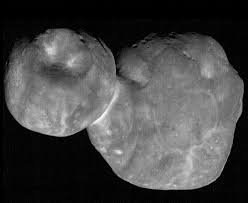-
Blog Post 8: How astro2110 Has Changed My View On Astronomy

Star Gazing Before coming into astro2110, I knew very little about astronomy. Now, after completing the course, my appreciation for astronomy has greatly increased. A few days before the semester started, one of my friends who is an astronomy nerd laughed at me for not knowing the phases of the Moon. I thought to myself, “I’m a CS nerd, why would I need to know the phases of the Moon”? I had forgotten just how interesting astronomy is as a whole. Never had I sat down and actually thought that there’s more to astronomy than just the phases of the Moon. There’s the Milky Way , and extremophiles, and dwarf planets, the Kuiper Belt, moons of other planets, constellations, nebulas, aliens, space missions, and much more. Learning about all of these topics and more makes me excited to learn more in the future. The galaxy is way bigger than I thought, and we’re just a mere speck in the midst of it all. Which means that I still have tons more to learn about what’s here on Earth and what is out there beyond the stars. Watching the lecture that Alan Stern gave about the New Horizons mission visiting Pluto refueled my curiosity about space exploration. The fact that we don’t know what’s out there and we’re constantly learning new things has influenced me to continue to keep up with astronomy in the future. Now I can go back to my friend and tell him every single one of the phases of the moon and maybe even throw one of my own astronomy questions at him.
-
Blog Post 7: What Will Happen If We Do Find Life Out There In Space?

Alien The common question when thinking about life in space is always “Is there even life in space”? But few people think about what would actually happen next if we were to find life out there beyond the stars. If we ever do receive a message from extraterrestrial beings, many people have this vision of it being a greeting message. The aliens will have decoded our friendly message that we sent to them and they’ll send a nice response in return, right? As time has progressed, some astrobiologists have started to believed that this is the optimal outcome. First we have to be able to decode the message. Let’s imagine that we don’t decode the message though. Could it be for our own good? The aliens might not send back a message as pleasant as ours. It may contain something devastating that could alter the future of Earth.
The bigger question that people are starting to ask now is “What will the alien’s message say, and will it be friendly”? Some people believe that the message will be a call to action to help humans. Aliens most likely have far more advanced technology than us humans, especially if they can figure out how to send a message from a different star system. They may instantly recognize the information in the messages that we send. It is possible that they will send a message telling us that our technology is lagging behind theirs and offer to lend a hand. There are others that believe if we receive a message like this, it could be a trap. The alien’s could act benign, but end up secretly waging war and plan to destroy the human race. Think of it as it as here on Earth. Another place has other living beings and resources on it that a certain group may want to control. Or, you find a group of beings that you know little to nothing about in a place where you thought you were alone. That could spell bad news for us.
So before you get too excited about finding extraterrestrial life, think about the possible outcomes. What would the aliens do? What would Earth do in response? What would you do? If you’d like to learn more about the possibilities of finding extraterrestrial life, you can visit this site.
-
Blog Post 6: Gravitational Slingshot

Gravitational Slingshot Have you ever played with a slingshot to shoot small items such as pebbles as a kid? Astronomers can also tap into their inner child by using a gravitational slingshot in space. A gravitational slingshot happens when a small object uses the gravitational pull of a larger object to speed itself up. Take a spacecraft as the smaller body and a planet as the larger body. When a spacecraft passes by a planet at a certain angle and encounters the planet’s gravitational attraction, the spacecraft can be shot forward with greater speed. It’s as if the planet is the slingshot and the spacecraft is the pebble. The key difference between a regular slingshot and a gravitational slingshot is that the spacecraft is stealing momentum from the spinning planet. Since the spacecraft ends up stealing some of the momentum of the spinning planet, the rotation of the planet slows down. The planets slows down by an extremely insignificant amount since it is much more massive than the spacecraft. To our eyes, the planet looks like it is moving the exact same speed as it did before. Although your traditional slingshot may not be as cool, you may one day be able to contribute to a space mission that uses a gravitational slingshot if you pursue astronomy!
-
Blog Post 5: Ultima Thule

Ultima Thule Most people have New Years goals of going to the gym more or spending more time with their family. The New Horizons team had a New Years goal to capture a clear image of Ultima Thule, the furthest known Kuiper belt object at that time, on a New Years flyby. Most people will look at a picture of Ultima Thule and think that it is just two rocks conjoined together. To astronomers, being able to capture this picture was a historic moment in history.
Ultima Thule’s appearance didn’t resemble any of the other Kuiper belt objects. Once the pictures made it back to Earth, it was classified as a contact binary that consists of two spheres that are connected. The larger sphere is called Ultima, while the smaller sphere is called Thule. What makes Ultima Thule so special is that it shows a snapshot of the beginning of planetary formation. By studying Ultima Thule, astronomers have been able to gain valuable insight into how planets form in both our own solar system and other distant ones.
-
What would happen if an asteroid struck present-day Earth?

We normally only see asteroids striking Earth in science fiction (what a relief!). NASA actually has an observatory whose sole purpose is to track both asteroids and comets and that appear like they might come close to Earth. During December of 2022, there were 5 asteroids that were placed on watch. Two of these asteroids were the size of a commercial jet. Luckily, all of these asteroids flew straight by Earth. In that same year, an asteroid thought to be this size of the New York City’s Empire State Building flew by Earth as well.
Although we haven’t witnessed a large asteroid hit Earth recently, the most famous asteroid hit Earth about 66 million years ago. The asteroid left a crater the size of a mountain near the cost of the Yucatan Peninsula in Mexico. It is believed that his asteroid caused massive tsunamis and was able able to block off sunlight from the amount of water and dust it flung into the air. This is the famous asteroid that is thought to have caused the extinction of the dinosaurs.
There are low chances of an asteroid hitting Earth. NASA has stated that all most of the asteroids that they have tracked have a low chance of actually making impact. In order for an asteroid to do significant damage to Earth, it would have to be at least the size of a house. If this type of asteroid were to hit Earth, concrete buildings and wooden structures around the impact site would be flattened. This would be enough to cause significant damage to a city. We may not have encountered asteroids that appear to hit Earth, but that doesn’t mean that there are unknown asteroids out there that could make their impact on our planet.
You can find out more about asteroids here
-
Blog Post 3: What will happen when our Sun dies???

Just as all things have a beginning, all things have an end. Unfortunately this applies to our Sun as well. As a kid, I used to think that the Sun was basically just like a lamp light in the sky. When a lamp runs out of batteries, all you have to do to make it shine again is replace its light bulb. This is not the case with the Sun. Our Sun has been burning brightly for about 5 billion years (that’s an extremely long time!). The Sun is expected to burn for a total of 10 billion years, so it’s about halfway through it’s life-cycle. The looming question is: “what will happen to the Sun and our solar system when the Sun dies”?
Originally, scientists believed that it would turn into a bubble of cosmic dust and gas. In order for that to happen though, the sun would have to be a bit more massive than it currently is. In about 5 billion years when the Sun uses up all of its nuclear fuel, it will turn into a red giant. Both Mercury and Venus will be swallowed and the Earth will be burnt to a crisp. It’s core will begin to shrink and then eject its outer layers to engulf everything to the outer layer of Mars. Fortunately, or unfortunately, we won’t be around to see all of this happen. Humans are actually only expected to live for about 1 billion more years because the Sun is gradually increasing in brightness. The Earth’s surface will eventually become so hot that it will be impossible for water to form. But until that time comes, humans are on the search for a new home in order to keep humanity alive!
You can find more information about what the end of our Sun’s life looks like here. If you need some more convincing from some professionals, here is a website where some scientists talk about the Sun’s end.
-
Historical Astronomers in Context
Chosen Astronomer
Galileo Galilei was born on February 15, 1564, in Pisa, Italy. He died on January 8, 1642, in Arcetri, Italy. You can find more great information about him here.
Historical events
The first Japanese invasion of Korea happened in 1592. As a response, Ming China sent an army to Korea to ward off the Japanese invaders and caused the caused a war that didn’t end until 1598. You can find out why this war was so important by visiting this site.
Pilgrims arrived at Plymouth Rock via the Mayflower on November 11, 1620, after a long voyage of 66 days. The passengers of the Mayflower were in search of a place where they could start anew and have the freedom they strongly desired. You can find out more about the journey of the pilgrims by clicking here.
Non-astronomy Related Historical Figure
William Shakespeare was said to have been born around April 23, 1564, and died on April 23, 1616. He was a famous English poet, playwright, and actor who is coined as the most influential English writer in all of history. You can learn more about how great of an impact Shakespeare made on the English language from this site.
Reflection
It was interesting learning how different astronomers can influence the work of later astronomers. Although some astronomers did make observations all on their own, there are some who still did some extraordinary work by analyzing the data and observations of astronomers before them. It’s also interesting to see just how many significant events can happen all at one time. There are so many groundbreaking discoveries, major wars, and important people that reside all in the same time period. Many important events were happening all over the world, not just in one country. It’s interesting to see how these events across the world affect each other in different time periods.
-
Blog Post 1 – Pluto Becoming a Dwarf Planet

Macmillan When I was in elementary school, I never understood why Pluto was called a dwarf planet. I called Pluto a “baby planet” because it looked so tiny compared to the rest of the planets. I thought the reason that it was called a dwarf planet was only because of its smaller size. The International Astronomical Union is the organization that created the 3 criteria that an object must meet in order to be considered a planet. This object must orbit a star, be large enough for gravity to force it to maintain a spherical shape, and be large enough to where its gravity clears its pathway when orbiting around the Sun. Pluto satisfies these first two requirements, but unfortunately fails to fulfill the third requirement. Therefore, the IAU decided to demote Pluto to be a dwarf planet. There was backlash from people all around the world since Pluto had been considered a planet for many years. Despite all of the backlash , the IAU stood firm in its decision. Although Pluto is a dwarf planet by definition, it will always be a regular planet in our hearts!
Sources:
-
Blog 0 post

Photo By Me This is my first ever headshot that was taken on Vanderbilt’s campus.
You can find some cool facts about links between music and astronomy here
-
Subscribe
Subscribed
Already have a WordPress.com account? Log in now.
